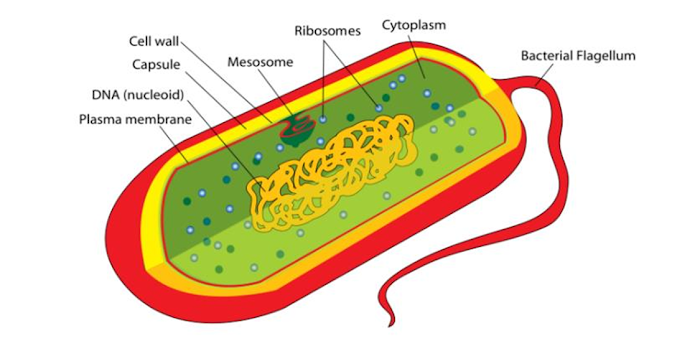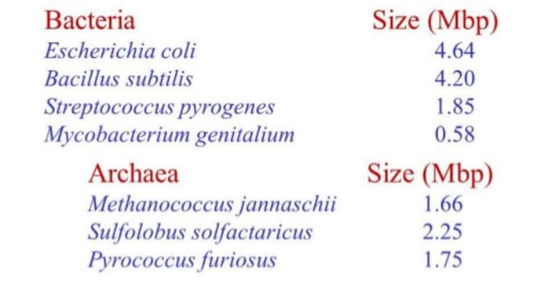
Genetic organization of Eukaryotes and Prokaryotes
Genetic organization of Eukaryotes and Prokaryotes
Introduction
Types of organisms
• Prokaryotes
• Eukaryotes
Prokaryotes
• Prokaryotes have a simple cellular organization.
• They do not have a nucleus and true organelles.
Eg: Bacteria and Archae
Eukaryotes
• Eukaryotes have a complex cellular organization with a membrane-bound nucleus and true organelles.
• Fungi, protists, plants, and animals are eukaryote
Prokaryote-Bacteria
Genetic material of prokaryotes
• Genetic material of prokaryotes floats in the cytoplasm
• Prokaryotes have a small genome and contain plasmids.
• They also have a large coiled double-stranded circular chromosome
• Bacteria have a large circular chromosome which is highly coiled.
• They also possess extra-chromosomal DNA known as plasmids.
• Plasmids are not necessary for their day to day survival.
• Plasmids contain important genes such as antibiotic-resistant genes, pesticide resistance genes, etc.
• In addition, these DNA molecules are small in size and are able to self-replicate. Due to these properties, they serve as very valuable vectors in recombinant DNA technology and cloning
Genetic material of eukaryotes
• The genetic material of eukaryotes resides inside the nucleus.
• Eukaryotes have a larger genome and do not possess plasmids.
• The eukaryotic genetic material is linear and wrapped around proteins called histones.
• It contains many sequences which are non-coding.
• Moreover, eukaryotic genes do not transcribe together. They transcribe separately and make their own mRNA molecules.
• One promoter regulates the transcription of one gene in eukaryotes.
Similarities between Genetic Material of Prokaryotes and Eukaryotes
• The genetic material of prokaryotes and eukaryotes are made up of DNA molecules.
• They contain double-stranded DNA build by four nucleotides.
• Both types of genetic material contain genes of Prokaryotes and Eukaryotes
Differences between Genetic Material of Prokaryotes and Eukaryotes
What is Genome?
Genome is the entirety of an organism's hereditary information.
It is encoded either in DNA or, for many types of virus, in RNA.
The genome includes both the genes and the non-coding sequences of the DNA.
DNA
• DNA (or deoxyribonucleic acid) is the molecule that carries the genetic information in all cellular forms of life and some viruses.
• It belongs to a class of molecules called the nucleic acids, which are polynucleotides - that is, long chains of nucleotides.
Nucleotide
• Each nucleotide consists of three components:
• a nitrogenous base: cytosine (C), guanine (G), adenine (A) or thymine (T)
• a five-carbon sugar molecule (deoxyribose in the case of DNA)
• a phosphate molecule
• The backbone of the polynucleotide is a chain of sugar and phosphate molecules. Each of the sugar groups in this sugar-phosphate backbone is linked to one of the four nitrogenous bases
DNA
• DNA's ability to store - and transmit - information lies in the fact that it consists of two polynucleotide strands that twist around each other to form a double-stranded helix.
• The bases link across the two strands in a specific manner using hydrogen bonds: cytosine (C) pairs with guanine (G), and adenine (A) pairs with thymine (T).
DNA – Double helix
• The double helix of the complete DNA molecule resembles a spiral staircase, with two sugar phosphate backbones and the paired bases in the centre of the helix.
• This structure explains two important properties of the molecule.
• First, it can be copied or 'replicated', as each strand can act as a template for the generation of the complementary strand.
• Second, it can store information in the linear sequence of the nucleotides along each strand.
DNA helix showing nitrogenous bases
Codons
• The order of the bases along a single strand constitutes the genetic code.
• The four-letter 'alphabet' of A, T, G and C forms 'words' of three letters called codons.
• Individual codons code for specific amino acids.
Eg., the codon AGC codes for serine, and the codon ACC codes for threonine.
Genetic code
• There are a two points to note about the genetic code:
• It is universal. All life on Earth uses the same code (with a few minor exceptions).
• It is degenerate. Each amino acid can be coded for by more than one codon. For example, AGA and AGG both code for the amino acid arginine
Codon Table
DNA replication
• The enzyme helicase breaks the hydrogen bonds holding the two strands together, and both strands can then act as templates for the production of the opposite strand.
• The process is catalysed by the enzyme DNA polymerase, and includes a proofreading mechanism
Gene
• A gene is a sequence of nucleotides along a DNA strand - with 'start' and 'stop' codons and other regulatory elements - that specifies a sequence of amino acids that are linked together to form a protein.
• Genes consist of three types of nucleotide sequence:
• coding regions, called exons, which specify a sequence of amino acids
• Non-coding regions, called introns, which do not specify amino acids
• Regulatory sequences, which play a role in determining when and where the protein is made (and how much is made)
Components of a gene
Genome organization in Prokaryotes
Significance
Of medical interest, bacterial genomics is also anticipated to play a significant role in speeding up the development of better therapies and vaccines for controlling disease-causing bacteria.
It will also be the cornerstone of anticipated DNA-based diagnostic tools that will hopefully enable doctors to make quicker, more accurate diagnostic of infectious disease.
Much of the information about the structure of DNA has come from studies of prokaryotes, because they are less complex (genetically and biochemically) then eukarotes.
Prokaryotes are monoploid = they have only one set of genes (one copy of genome).
Prokaryotes genomes are exemplified by the E. coli chromosome.
The bulk of the DNA in E. coli cells consists of a single closed-circular DNA molecule of length 4.6 million base pairs.
The DNA is packaged into a region of the cell known as nucleoid.
Size of bacterial Genome
Gene content
Gene portion of bacterial genome is around 85-95%.
Bacteria posess few genes such as in case of Mycobacterium genitalium (480genes).
The highest gene content is present in case of Bradyrhizobium japonicum (8317 genes).
The average gene content is 3,100 genes per genome.
General features of Bacterial Chromosomes
• Not all bacteria have a single circular chromosome.
• Some bacteria have multiple circular chromosomes.
• Many bacteria have linear chromosomes and linear plasmids.
Examples of Bacteria
Agrobacterium tumefacians:
One linear (2.1 Mb) +
One circular (3.0 Mb) +
Two circular plasmids (450 kb + 200 kb)
Vibrio cholerae: two circular chromosomes, one of these chromosomes contain the genes involved inmetabolism and virulence, while the other contains the remaining essentialgenes.
Bacillus thuringiensis:
One circular (5.7 Mb) +
Six plasmids (Each > 50kb)
DNA Supercoiling
One way prokaryotes compress there DNA into smaller spaces is through supercoiling.
Genomes can be negatively supercoiled, meaning that the DNA is twisted in the opposite direction of the double helix, or positively supercoiled, meaning that the DNA is twisted in the same direction oa the double helix. Most bacterial genomes are negatively supercoiled during normal growth.
Cells maintain DNA in an underwound state to
1) Facilitate its compaction by coiling.
2) Enable the enzymes responsible for DNA metabolism to separate DNA strands.
This slate however causes the molecule to be thermodynarnicully strained. The strain is accommodated by coiling of the axis of DNA on itself to form supercoil.
Supercoiling
Topoisomerases
Topoisomerases are enzyme that regulate the over-winding or under-winding of DNA.
Topoisomerases areisomerase enzyme that act on the topology of DNA.
Role of Topoisomerases
The winding problem of DNA arises due to the interwined nature of its double-helical structure.
During DNA replication and transcription, DNA becomes overwound ahead of a replication fork.
In left unabated, this torsion would eventually stop the ability of RNA & DNA Polymerase involved in these process to continue down the DNA strand.
Topoisomerases bind to either single-stranded or Double Stranded DNA and cut the phosphate backbone of the DNA.
This intermediate break allows the DNA to be untangled or unwound, and at the end of these processes, the DNA backbone is resealed again.
Types of Topoisomerases
1) Topoisomerases I: breaks only one strand
2) Topoisomerases II: breaks both strand
Type I Topoisomerases
Type I topoisomerases are enzymes that cut one of the two strands of double-stranded DNA. Relax and strand. And renewal the strand.
Type II Topoisomerases
Type II topoisomerases cut both strands of the DNA helix simultaneously. They use the hydrolysis of ATP. Unlike Type I topoisomerases. These enzymes change the linking number of circular DNA bv±2.
GENOME ORGANIZATION IN EUKARYOTES
Genome in the structure of DNA
Eukaryotic genome
• Example: C. elegans
• 10 chromosomes
• 19,099 genes
• Coding region - 27%
• Average of 5 introns/gene
• Both long and short duplications
Eukaryotic genome organization
1. Multiple genomes: nuclear, plastid: mitochondria, chloroplasts
2. Plastid genomes resemble prokaryotic genomes
3. Multiple linear chromosomes, total size 5-10,000 MB, 5000 to 50000 genes
4. Monocistronic transcription units
5. Discontinuous coding regions (intrans and exons)
6. Large amounts of non-coding DNA
7. Transcription and translation take place in different compartments
8. Variety of RNAs: Coding (mRNA, rRNA, tRNA), Non-coding (snRNA, snoRNA, MicroRNAs, etc).
9. Often diploid genomes and obligatory sexual reproduction
10. Standard mechanism of recombination: metosis
Genome
Structural genes – DNA segments that code for some specific RNAs or proteins. Encode for mRNAs, tRNAs, snRNAs, scRNAs.
Functional genes –Regulatory sequences – occur as regulatory elements (Initiation sites, promoter sites, operator sites, etc.)
Nonfunctional genes –introns and repititive sequences. Needed for coding, regulation and replication of DNA. Much more in no then functional sequences.
Prokaryotic and Eukaryotic cells
Genome of all living organisms represents their hereditary material and is formed of DNA.
In Prokaryotic cells – genomic DNA forms a single circular chromosome, without basic proteins, lies in the cell cytoplasm in nucleoid region.
In Eukaryotic cells – DNA associated with basic proteins (histones), form long chromatin fibers. Chromatin fibers form a network, enclosed in a double layered nuclear envelop, condenses into chromosomes during cell division.
Comparative genome sizes of organisms
Chromatin
Chromatin is the complex combination of DNA and proteins that makes up chromosomes.
The major proteins involved in chromatin are histone proteins; although many other chromosomal proteins have prominent roles too.
The function of Chromatin is to package DNA into smaller volume to fit in the cell, to strengthen the DNA to allow mitosis and meiosis and to serve as a mechanism to control gene expression and DNA replication.
Organization of Chromatin
Structural proteins – histones (packing proteins)
Main structural proteins found in eukaryotic cell.
Low molecular weight basic proteins with high proportion of positively charged amino acid.
Bound to DNA along most of its length.
The positive charge helps histone to bind to DNA and play a crucial role in packing of long DNA molecules.
Functional Proteins – Non-Histones
Associated with gene regulation and other functions of chromatin.
Chemical Composition of Chromatin
DNA: 20-40% most important chemical constituent of chromatin
RNA: 5-10% associated with chromatin as;
Ribosomal RNA (rRNA)
Messenger RNA (mRNA)
Transfer RNA (tRNA)
Proteins: 55-60% associated with chromatin as;
Histones: very basic proteins, constitute about 60% of total protein almost 1:1 ratio with DNA, Five types- H1, H2a, H2b, H3 and H4.
Non Histones: they are 20% of total chromatin protein, 50% structural (actin, L& B tubulin and myosin) – contractile proteins, function during chromosome condensation and in the movement of chromosomes during mitosis and meiosis. 50% include all enzymes and co-factors- involved in replication, transcription and regulation of transcription.
TYPES OF CHROMATIN
Euchromatin
Lightly packed form of chromatin that is rich in gene concentration.
Takes up light stain and represent most of the chromatin that disperse after mitosis has completed.
Consist of structural genes which replicate and transcribe during G1 and S phase of the interphase.
Considered genetically active chromatin, since it has a role in their phenotypic expression of the genes.
DNA is found packed in 3-8 mm fiber.
During metaphase it takes up dark stain.
Heterochromatin
Tightly packed form of chromatin that takes up deep stain during interphase and prophase but metaphase takes up light stain.
Chromomeres, centromeric regions, and knobs also take up dark staining, of which centromeric regions and knobs are the true Heterochromatic. (chromomeres are transcribed so not true H. C.).
In the chromosomes all the centromeres fuse to form a long heterochromatic mass called chromocentre.
Heterochromatin consist of highly repetitive DNA sequences. It is late replicating during the s-phase of the cell and is not transcribed.
• Eukaryotic Chromosomes Demonstrate Complex Organization Characterized by Repetitive DNA
• Repetitive DNA sequences are repeated many times within eukaryotic chromosomes.
Classification of repetitive DNA
• Satellite DNAis highly repetitive and consists of short repeated sequences.
• Telomeric DNAsequences consist of short tandem repeats that contribute to the stability and integrity of the chromosome.
• Moderately repetitive DNA includes:
- Variable number tandem repeats (VNTRs)
- Minisatellites
- Microsatellites
• Short interspersed elements (SINES) and long interspersed elements (LINES) are dispersed throughout the genome rather than tandemly repeated, and constitute over 1/3 of the human genome.
• These transposable elements are generated via an RNA intermediate and are referred to as retrotransposons.
• The Vast Majority of a Eukaryotic Genome Does Not Encode Functional Genes
• Only a small portion of the eukaryotic genome (2%-10%) constitute protein-encoding genes.
• There are also a large number of single-copy noncoding regions, some of which are pseudogenes.
Function of chromatin
"The function of the chromatin is to carry out the genetic information from one generation to another, by encoding the past history and future prospects of the cell. DNA.., being the only permanent component of chromatin, is the sole genetic material of eukaryotes. It never leaves the cell, thus maintaining heredity of the cell"






























0 Comments: